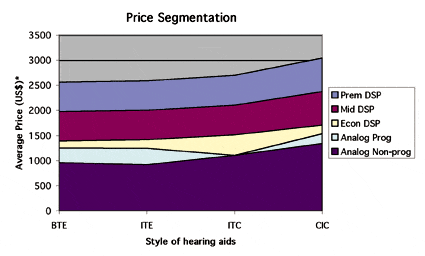For some open fittings, using a custom earmold would result in a better fit
With the use of a simple modification of the earmold plumbing, many additional individuals should be able to be helped with BTE hearing aids. The modification of the earmold plumbing should be of additional assistance in fitting those individuals who are borderline candidates for some open-mold fittings due to excessive feedback with the use of the stock dome molds.
Open-mold hearing instruments have quickly gained popularity, and most major manufacturers now offer open-fit hearing instruments. In February of this year, a Hearing Industries Association (HIA) survey indicated that BTEs with a size 312 or size 10 battery (eg, most likely an “open-fit” aid) constituted 12% of the market.1 The HR 2006 Dispenser Survey2 suggested that about one-quarter (24%) of all the BTEs dispensed by hearing care professionals now use open-mold fittings.
This re-entrance of open-mold hearing aids has brought around numerous advantages. Likewise, there are also some potential negatives caused by the renewed interest in open fittings. In a recent informal survey conducted by the author, it was found that approximately 38% of the individuals being fit with open-mold hearing instruments would have most likely been better served by a close-mold fitting.
The marked reduction in the occlusion effect using the presently supplied stock open (dome) earmold is perhaps the single greatest noticeable advantage to the hearing aid user. By the same token, the use of the stock open mold precludes the elimination of a considerable amount of feedback. It is the feedback effect that, in the author’s opinion, encourages the under-fitting or underutilization of amplification by an individual with a hearing loss. The result: When amplification is fit specifically for the comfort of the individual, oftentimes insufficient gain is the result.
The most common comment by the individual recently fit with a dome earmold is that it is much more comfortable than the aid they were previously using. This is most likely due to the absence of the occlusion effect, as well as the comfort of the dome fitting.
The context of this short article should not be construed to convey a lack of enthusiasm for the open-mold fittings; quite the contrary, there is ample reason to be excited about the progress that has been made in the hearing industry with the use of these open-fit devices. However, it is this author’s opinion that, without proper education on fundamental earmold concepts, there is a serious danger that individuals will not be adequately fit using open-molds, and therefore will not obtain the maximum benefit from amplification.
It is the author’s belief that some individuals would be far better served using other types of hearing aids or a modification of the currently available stock earmolds using open or other BTE devices.
Advantages and Disadvantages of Open Fittings
Some of the advantages of open fittings are:
Instant fits. Individuals can be instantly fit with a hearing aid when they come into the office with a hearing problem. There is no need for waiting a week while the hearing aid or earmold is being made and returned for the individual.
Improved patient expectations. Individuals can try a hearing aid and know that they are getting exactly what they hear in the trial session because they will be fit with the same aid they are trying.
Simplified transactions. Hearing care professionals dispensing the hearing aids can receive their money at the time of the fitting.
Simplified inventories. A supply of the hearing aids and open molds can be maintained by the dispenser in the office/practice. This eliminates the waiting period for getting a hearing aid back from the manufacturer.
Fewer returns. In many more cases, there simply is no return to the factory if an aid is not deemed appropriate.
Some of the disadvantages of open-mold fittings are:
Limited fitting range. There is a limited degree of hearing loss which can be satisfactorily fit with the open-mold concept because open fittings (or larger vent diameters) reduce low frequency gain. For example, Kuk3 in a recent discussion on earmold venting reports that, if the goal is to optimize own-voice quality (with speech understanding being a close second-place objective), then open-fittings should be limited to individuals with mild losses and for those who have essentially normal hearing (less than 20 dB HL) at 500 Hz.
Limited earmold modifications. There are limited sizes for the open-mold tips being universally used, and there is a very limited ability to modify the plumbing of these earmolds.
Reduced directionality. There is a serious question if the use of directional microphone systems on open-mold fittings are as advantageous as with occluded earmold fittings. Directional hearing aids (and the ability to understand speech in a variety of listening situations, including hearing in noise) have been proven to be a leading factor correlated to customer satisfaction with hearing aids.4 Although I have measured some beneficial effects of directionality using open-mold fittings, it is not as dramatic as with other fittings. The literature tends to suggest that directional advantage may be reduced by as much as 50%.5,6
Potential for feedback with more severe losses. When attempts are made to fit patients whose hearing loss exceed the recommended fitting range, a considerable amount of feedback is the frequent result. This frequently causes the dispensing professional to reduce the gain and output of the instrument so that no feedback is present. Although successful, this procedure often negates the maximum benefit that an individual should receive from amplification.
Jury still out on extended fitting ranges. Even though the open fitting might provide insufficient high-frequency amplification for some patients’ hearing loss, the comfort and natural sound quality associated with the open-mold fitting is often readily accepted by individuals who have worn other types of hearing aids. This authors’ limited time using the recommended fitting does not provide enough information as to whether the aids would be returned due to the insufficient amplification.
Possible comfort issues. Upon fitting the hearing aids with the stock open earmold, there is often a considerable amount of itching in the air canal. This appears to be substantially more prevalent than with other fittings.
Modifying the Open Fit
In view of some of the negative aspects suggested above, some modifications of open-fit earmold plumbing were tried by the author. The following information is one example of how one can overcome the disadvantages of the open-mold fitting protocol. Although I have numerous individuals wearing the open-mold fittings as part of an ongoing research study, this article presents only one illustrative example (a more complete study is underway and that data will be published at a later date). Thus, the following information is shown merely as an example of what may be accomplished with modified earmolds.
The data was obtained using a Sonic Ion aid that utilized two separate programs, and similar results should be obtainable using nearly any of the commercially available aids which use with the manufacturer’s open-dome earmold concept. Figures were obtained using Frye 6500 test equipment, and are presented merely as an example (eg, they are not meant to be a statistically measured differences from a large, diverse population). In both Programs 1 and 2, the data was recorded as indicated below.

In Figure 1, using Program 1, “Line A” represents data obtained using the medium-sized dome (MSD) supplied by the manufacturer, and the data are typical of what one would expect using this hearing aid setting and earmold configuration. “Line B” represents data obtained using a custom-made open mold from Perfect Seal Laboratories Inc (PSLI). “Line C” in Figure 2 represents data obtained using a modified custom mold (MCM) with a 2 mm vent and the earmold inserted slightly (medially) around the second turn of the ear canal.

It is obvious—as would be expected—that more gain can be obtained at the eardrum using either the PSLI or the MCM mold compared to the MSD mold. Interestingly, no marked occlusion was reported when using the MCM mold with just a 2 mm vent. This observation has been reported by a number of subjects who had previously reported significant occlusion when using other fittings such as ITE and CIC hearing aids. The absence of occlusion with the MCM is, in all probability, due to the placement of the mold fairly deep inside the ear canal. Similar information was presented as far back as the 1950s (eg, for a discussion on the advantages of deeper fittings and a literature review, see Staab et al).7

Figure 3 shows the response from both programs using the MSD earmold and the PSLI earmold. There is a reduction in the difference between MCM and PSLI using Program 2. Figure 4 shows the results using the MCM mold. There are other differences in the frequency response recorded which can clearly be seen from these data. When using Program 1, for example, both the MCM and the PSLI show greater response levels out through 2,600 Hz. Further, there appears to be two obvious differences between the PSLI versus the MCM:

1) The PSLI earmold shows greater high frequency response when using Program 2.
2) There is also considerable feedback when using the PSLI earmold (compared to the MCM earmold).
Sonic Innovations was kind enough to modify their Ion fitting so that I am now able to deliver considerable more gain in the low frequencies below 1,000 Hz than is shown on the graphs shown here. Although I am not completely familiar with all of the recently developed devices and programs used in open fittings, it would seem logical that other hearing aid manufacturers should be able to do similar modifications for their systems.
Conclusions
The re-introduction of the open-mold fitting has created great acceptance for the use of amplification with the hearing impaired. This is especially true with those who have the high frequency hearing loss that is so prevalent in today’s society.
With the use of a simple modification of the earmold plumbing, many more individuals should be able to be helped with this type of hearing aid. Modification of the earmold plumbing should be of additional assistance in fitting those individuals who are borderline candidates for the open-mold fitting due to excessive feedback with the use of the stock dome molds.
A well-rounded knowledge of earmold acoustics and modifications will go a long way in providing your patients with appropriate gain levels for their hearing loss while minimizing feedback or occlusion problems.
Acknowledgements
Although they should not be held accountable for any of the information in this short article, I would like to acknowledge Sonic Innovations for their willingness to loan me the aids that were used in this article, as well as the follow-up study that will be published soon.
References
1. Hearing Industries Association (HIA). Special survey results on BTE, directional, and telecoil use. Alexandria, Va: HIA; Feb 22, 2006.
2. Strom KE. The HR 2006 dispenser survey. The Hearing Review. 2006;13(6): 16-39.
3. Kuk F. How do vents affect hearing aid performance? The Hearing Review. 2006;13(2):34-42.
4. Kochkin S. Customer satisfaction with single and multiple microphone digital hearing aids. The Hearing Review. 2000;7(11):24-29.
5. Fabry D. Facts vs myths: The “skinny” on slim-tube open fittings. The Hearing Review. 2006;13(5):20-25.
6. Ricketts TA. Directional hearing aids: New designs and predictions applied to old concepts. Hear Jour. 2006;59(6):10-18.
7. Staab WJ, Dennis JM, Schweitzer C, Weber JE. Measuring the occlusion effect in a deep-fitting hearing device. The Hearing Review. 2004;11(13): 44-50.
Correspondence can be addressed to HR or Darrell E. Rose, PhD, 981 West 170 South, Orem, Utah 84058; e-mail: [email protected].
Darrell E. Rose, PhD, is a retired audiologist and the former director of audiology at the Mayo Clinic, Rochester, Minn.





